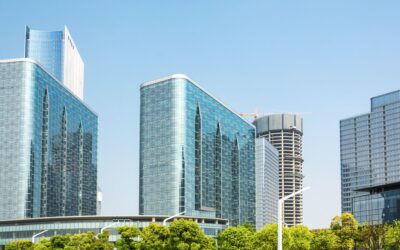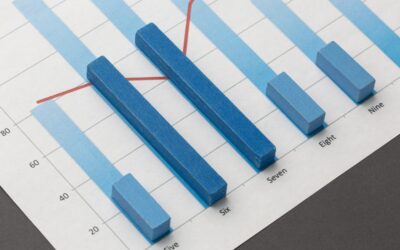It’s true what they say: Timing is everything in commercial real estate.
From the peaks of economic prosperity to the valleys of recession, market cycles shape the landscape of CRE—and only when you understand and anticipate these cycles can you spot profitable investments and avoid costly missteps.
Recognizing and responding to market trends is as art as science. So, how do you master these CRE phases and position your portfolio to capitalize on opportunities and mitigate risks?
Commercial real estate market cycle: The 4 phases
The CRE market typically follows a cyclical pattern: recovery, followed by expansion, hyper supply, and recession, which then cycles back to recovery.
How long each phase lasts can vary depending on economic conditions, policy decisions, and other market factors, but expansion and recession phases are generally shorter.
Throughout this blog, we’ll use the ‘tide’ metaphor to simplify the cycles. Think of these stages as ocean tides with highs and lows that dictate the pace of market activity.
Phase 1: Recovery
During this stage, the tide begins to rise. You’ll notice high vacancy rates (empty storefronts in malls and strip centers) and lower rental rates. This sets the stage for tenants to strike favorable lease deals, including lower utility costs.
This phase kicks off at the bottom of the trough following a halt in the excessive construction from the last cycle.
Pinpointing the exact market trough is tricky because recovery shares traits with the recession phase (particularly low occupancy and minimal leasing activities). New construction is scarce, and rental growth may stagnate or decline, occasionally falling below inflation.
CRE investment strategies during the recovery phase
Opportunistic:
Jump in early during the recovery phase to find properties at a discount — usually distressed assets that you can potentially reposition when the market rebounds.
With suitable CRE loans and financing solutions, you can buy properties and upgrade them from distressed to stable, hold them for two to four years, and sell them for a profit during the next expansion phase.
Core:
It can be highly profitable to invest in core properties during recovery, especially if they will likely see significant lease turnover in the next two to four years.
The game plan is to acquire top-notch assets in prime locations to benefit from potential rent hikes in the upcoming cycle (through lease renewals and filling vacancies left from the recession) and then refinance or sell the asset during the expansion phase for peak value.
Value-add:
If you’re planning a value-add strategy during a recovery phase, do your due diligence. Don’t be fooled by temptingly low CRE property prices.
Your business plan should be solid, with realistic projections and contingency measures to account for potential delays in leasing activity until the market enters a more robust phase.
Phase 2: Expansion
The ocean’s tide is reaching its peak during this stage. The economy is thriving, and businesses are growing — which often means CRE demand surges. Vacancy rates plummet, and rental rates start their ascent.
Landlords are back holding the advantage in lease negotiations across various property types — including retail centers. The broader economic indicators are also positive: GDP growth and employment rates are robust.
Not surprisingly, construction activity intensifies in the expansion phase. This is a good thing, but it’s also critical to watch for signs of overbuilding and speculative excess that can upset the market’s balance.
CRE investment strategies during the expansion phase
Development:
Now is an excellent time to develop or redevelop properties, as the current demand and leasing momentum allow properties to stabilize quickly upon completion.
Core-Plus:
If you’re a CRE investor seeking lower risk, you might want to consider Core-Plus properties such as class-A office buildings and grocery-anchored shopping centers.
Value-add:
The expansion phase is golden for value-add investments. During this time, savvy CRE investors can snap up properties with existing issues at prices well below their potential stabilized value, pour capital into renovations, and reposition them swiftly.
Thanks to robust market absorption, these assets can quickly reach full value, which means profitable refinancing or sales.
Phase 3: Contraction/Hyper supply
This phase is when the tide starts to turn — when the balance between supply and demand during the expansion phase tips into excess and leads to oversupply.
This surplus can result from too much building or a downturn in demand triggered by economic shifts.
For example, a dip in GDP could lead to higher unemployment and reduced consumer spending, which may exacerbate the oversupply in the CRE market. Rent growth might still be positive but tends to slow down, and vacancies start to increase.
Investment strategies during the contraction / hyper-supply phase
Core:
Some CRE investors might choose to sell their assets to avoid anticipated declines in property values.
But suppose you have a core property with solid occupancy, a tenant roster full of credit-worthy businesses, and leases averaging more than five years until expiration.
In that case, there’s no need to worry — such as CRE assets being well-suited to weather the downturn and optimally positioned for the next market upswing.
Opportunistic:
Once hyper supply sets in, CRE owners unprepared for the looming recession might hastily sell off properties at prices close to recession levels.
This is an excellent opportunity to leverage your capital strength to acquire these assets at a bargain, as long as you factor recessionary risks into the pricing.
Phase 4: Recession
By this phase, the tide recedes to its lowest point. The economy sputters, and vacancies soar — landlords and tenants face challenging times.
Investment strategies during the recession phase
Opportunistic:
Recessions are prime times to purchase distressed assets at prices far below their replacement costs. The likelihood of finding properties in distressed situations — such as those managed by special servicers or undergoing lender foreclosures — is at its highest during this phase.
To take full advantage of a recession as a CRE investor, you will need access to CRE loans from lenders who understand the cycle. Your funding should support a patient and well-capitalized approach that is crucial during this period.
As the market begins to recover and the proverbial sun starts shining again, you can start repositioning your assets and sell them off towards the end of the recovery phase or at the beginning of the next expansion phase.
What is the current market cycle?
Which phase is the CRE market currently in? Pay attention to both macroeconomic and microeconomic indicators.
- Macroeconomic indicators such as GDP growth, unemployment, and interest rates greatly influence consumer confidence and investment activity in the CRE market.
- Meanwhile, microeconomic indicators specific to the CRE market — particularly vacancy rates, rental prices, and absorption rates — offer more localized insights into supply and demand dynamics.
Aside from these broader indicators, you also need to look at several other factors:
- Population shifts can drive demand for various properties, primarily residential and retail.
- Tax incentives, zoning regulations, and infrastructure investments can shape CRE market trends.
- The overall sentiment of consumers regarding the economy can impact their willingness to make purchases.
Things to remember
The phases of the real estate cycle don’t necessarily unfold over equal periods. For instance, a recovery phase might be brief and swiftly give way to expansion, or it could linger for years.
The total duration of cycles can vary significantly, too —one cycle might last nine years, but there’s no guarantee the next will follow the same pattern.
Additionally, different asset classes (such as office, retail, or multifamily residential) move through the phases at varying speeds, influenced by their intrinsic characteristics and specific locations — from the metro level down to individual neighborhoods.
For example, the office sector might be booming in a particular market while suburban properties might struggle to recover. In contrast, urban office locations could be on the brink of oversupply.
Here’s a closer look at how the real estate cycle impacts different CRE asset classes:
Multifamily:
Housing remains essential irrespective of economic conditions, making this class relatively stable. However, increased job growth during economic booms can boost rental and occupancy rates and sometimes trigger more construction.
Industrial:
Warehouses and distribution centers also often remain resilient despite downturns because of the steady demand for e-commerce and logistics. Economic upswings push the demand for these spaces even higher.
Retail:
The retail sector is one of the fastest-evolving CRE segments as it balances e-commerce convenience with the brick-and-mortar experience. It’s sensitive to macroeconomic trends and will thrive during expansions when job and wage growth fuel consumer spending.
Office:
Demand for office space usually rises with a strong economy and declines during downturns. However, the shift towards hybrid work models has altered the supply-demand balance in favor of modern office buildings equipped with top-notch amenities that attract today’s workforce.
These variances are precisely why it’s important to diversify your CRE investment portfolio. Spread investments across different property types and locations to mitigate the fluctuations and capitalize on performance peaks more effectively.
Conclusion
As a CRE investor, you must secure reliable financing wherever you are in the market cycle. The proper financial support can make all the difference, whether capitalizing on opportunities in a prolonged recession or quickly expanding your portfolio in a booming market.
Here at Private Capital Investors, we, as private commercial real estate lenders, understand the nuances of each phase of the CRE cycle and can offer tailored financing solutions based on your goals. Think of us as a CRE investment partner who understands your concerns and ambitions.
Reach out to us, and let’s discuss how our different CRE loan options can support your projects, regardless of the market’s current phase.





